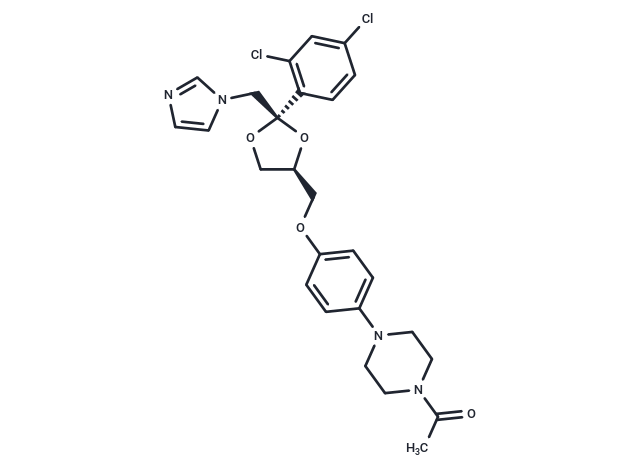Shopping Cart
Remove All Your shopping cart is currently empty
Your shopping cart is currently empty
Ketoconazole (R-41400), a CYP3A4 inhibitor, is an imidazole anti-fungal agent.

| Pack Size | Price | USA Warehouse | Global Warehouse | Quantity |
|---|---|---|---|---|
| 50 mg | $31 | In Stock | In Stock | |
| 100 mg | $44 | In Stock | In Stock | |
| 500 mg | $68 | In Stock | In Stock | |
| 1 g | $89 | In Stock | In Stock | |
| 1 mL x 10 mM (in DMSO) | $48 | In Stock | In Stock |
| Description | Ketoconazole (R-41400), a CYP3A4 inhibitor, is an imidazole anti-fungal agent. |
| Targets&IC50 | Cyclosporine oxidase:0.19 mM, Testosterone 6β-hydroxylase:0.22 mM |
| In vitro | Intraperitoneal administration of Ketoconazole (25 mg/kg) in rats significantly reduced plasma corticosterone levels and decreased self-administration of low doses of cocaine. Rats treated with Ketoconazole exhibited enhanced bioavailability of digoxin, increasing from 0.68 to 0.84, with the mean absorption time decreasing from 1.1 h to 0.3 h. Moreover, the oral area under the curve (AUC) for digoxin increased from 63 mg·h/L to 411 mg·h/L, while the intravenous AUC also rose from 93 mg·h/L to 486 mg·h/L. |
| In vivo | In HT29-S-B6 colorectal cancer cells, Ketoconazole decreased cell proliferation and [3H]thymidine uptake in a dose-dependent manner, with an IC50 of 2.5 mM. Ketoconazole also inhibited [3H]thymidine uptake in both Evsa-T and MDA-MB-231 cell lines, with respective IC50 values of 2 μM and 13 μM. Within 24 hours, Ketoconazole induced a dose-dependent reduction in the S-phase cell population (from 17% to 3%) and a corresponding increase in the Go-G1 phase cell percentage (from 64% to 80%) in HT29-S-B6 cells. By competitively binding with [3H]Dexamethasone, Ketoconazole inhibited fibroblast glucocorticoid receptors, with an IC50 of 0.3 mM. Several Aspergillus species were sensitive to Ketoconazole, with a minimum inhibitory concentration of 0.03 μg/mL. |
| Kinase Assay | Whole Cell [3H]R1881 Binding Assay: Fibroblasts are grown to confluence in five or six 150 cm2 tissue culture flasks for routine assay. This usually requires 4-6 weeks from the time of the initial seeding of the cell line. All studies are performed between passages 3-20. Two days before assay, the medium is changed to one lacking fetal calf serum. This is repeated again 24 hours before assay. Competition assays are performed with 0.5-1.0 nM [3H]R1881 and increasing amounts of the nonradioactive compounds. Binding to low affinity sites is determined in the presence of 5 × 10-7 M R1881 and is subtracted from whole cell binding of [3H]R 1881 obtained in the absence of any inhibitor to assess binding to 5 high affinity site |
| Cell Research | HT29-S-B6 cells (5×105) are plated in 35-mm Petri dishes. The next day, the medium is changed and effectors are added in a small volume (10-20 μL). The incubation medium is renewed every day during the experiments. The same triplicate dishes are used for cell counts, [3H]thymidine incorporation, and flow cytometry. [3H]Thymidine (0.5 μCi) is allowed to incorporate for 24 hours; at the end of incubation, cells are rinsed with 1 mL of medium, detached with 1 mL of trypsin-EDTA, and diluted (1:3) with the culture medium. An aliquot (0.5-1 mL) is used for cell count with a Coulter Counter.(Only for Reference) |
| Synonyms | Xolegel, R-41400, Extina, (±)-Ketoconazol |
| Molecular Weight | 531.43 |
| Formula | C26H28Cl2N4O4 |
| Cas No. | 65277-42-1 |
| Smiles | C([C@]1(O[C@@H](COC2=CC=C(C=C2)N3CCN(C(C)=O)CC3)CO1)C4=C(Cl)C=C(Cl)C=C4)N5C=CN=C5 |
| Relative Density. | 1.4046 g/cm3 (Estimated) |
| Color | White |
| Appearance | Solid |
| Storage | Powder: -20°C for 3 years | In solvent: -80°C for 1 year | Shipping with blue ice/Shipping at ambient temperature. | |||||||||||||||||||||||||
| Solubility Information | DMSO: 25 mg/mL (47.04 mM), Sonication and heating are recommended. | |||||||||||||||||||||||||
| In Vivo Formulation | 10% DMSO+40% PEG300+5% Tween 80+45% Saline: 0.53 mg/mL (1 mM), Solution. Please add the solvents sequentially, clarifying the solution as much as possible before adding the next one. Dissolve by heating and/or sonication if necessary. Working solution is recommended to be prepared and used immediately. The formulation provided above is for reference purposes only. In vivo formulations may vary and should be modified based on specific experimental conditions. | |||||||||||||||||||||||||
Solution Preparation Table | ||||||||||||||||||||||||||
DMSO
| ||||||||||||||||||||||||||
| Size | Quantity | Unit Price | Amount | Operation |
|---|

Copyright © 2015-2025 TargetMol Chemicals Inc. All Rights Reserved.